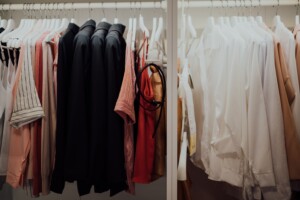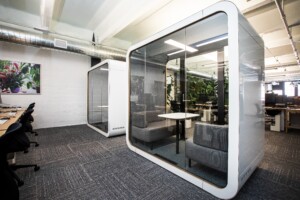The words “Home Studio” sound pretty high level, right? Well, trust me when I tell you it doesn’t have to be. It can be as simple as a walk-in closet or a room divider or a blanket. I am a Home Studio Coach for Such A Voice and I help hundreds of students turn whatever space they have into a quality home studio. The ideas I am about to discuss are highly effective and cost next to nothing to set up.
What do you mean by “echo”?
Many people new to voice-over don’t always know what we mean by “echo”. Yes, echo in its purest form is the, “HELLO, HEllo, Hello, helloooo” effect you hear when shouting in a canyon. In voice-over, it is an effect that makes your voice sound hollow, like you are speaking into a large tin can.
How does echo happen?
Echo or Room Reflection occurs when sound waves bounce off hard surfaces and “reflect” back into the front of your microphone. This means that anytime you are in a large room with hard walls and windows you will get a high level of room reflection on your recordings.
Why sound treatment matters
Why can’t I just set up my space in my loft, or home office or huge living room with the nine-foot high ceilings? You can, but you won’t get work. The main reason we don’t set up our space in rooms with no sound treatment is because it creates room reflection, which is not desirable for any voice recording. Sound treatment absorbs the room reflection, allowing you to create a clean, echo-free recording. Another important thing to note is that you can’t fix room reflection with software, so proper sound treatment is necessary from the start.
What should I do?
The most important place to put your sound treatment is behind you, which is in front of the mic. Your output speakers are typically facing the back wall. When the sound comes out, it hits the back wall and reflects into the front of your mic. Sound treatment behind you absorbs this echo.
Many people start out by putting their sound treatment on the wall in front of them. It may look nice but it is essentially ineffective. Remember: the output is typically being sent to the wall behind you. Plus in most cases, the back of the mic doesn’t pick up anything, or if it does it is very little (unless you have a ribbon mic where you can use the front or the back, but I digress).
Ok, so now I know what it is and how to lessen it; what’s next?
Now you can set up your studio. There are many ways to set up an almost free and highly effective studio space.
Size
The smaller the better. I don’t want you in a one foot by one foot area, but the smaller the space, the easier it is to contain and control the sound.
Materials
Studio foam
-
- You can get cheap foam on Amazon or somewhere likeThe Foam Factory. Thicker is better, but it is also more expensive so use what your budget allows. You can always upgrade when you start making money with your VO career.
Thick comforters
We all have them somewhere in the house. Dig them out and stick them to the walls behind you using velcro, thumbtacks, or nails. Or you can hang one from the ceiling behind you. I set something like this up to show my students different ways to use the space.
-
- Take two eye screws and screw them into the ceiling (find the joists). Screws should be about three feet apart and about a foot in front of you.
- Attach a bungee end to each screw
- Flip the top of the blanket over the bungee and use some clamps to secure it.
- When you put it over you it will drape around your back and sides.
I tested this to make sure it was a solid plan. I have a professional studio in my home where I have recorded most of my audiobooks. I recorded my last few books in the “blanket studio” and the differences were negligible. No echo in either.
Moving Blankets
Same idea as the comforter. Some moving blankets come with grommets so you can easily hang those from the ceiling as well
Room Dividers
Those tri fold room dividers are great and you can usually find them in thrift stores or on craigslist. Set it up so the two sides flank you and the middle piece is directly behind you. Throw those comforters or moving blankets over it and you are all set.

The Walk-In Closet
If you have a walk-in closet, this is typically the best setup. Make sure you leave the clothes in the closet! Clothing is one of the best sound treatments. Make sure you set up your mic to face the clothing (i.e. the clothing is behind you).
But, what about noise?
Ah, yes, background noise. Noise comes from a number of different places and getting rid of it depends on where it is coming from.
- AC, heating, fans, etc.
- Turn them off before recording
- TV’s, kids, spouse, pets
- Turn them off before recording. Only kidding! You’ll have to find the best times to record, which could be at 4 am or 11 pm. Don’t bring Misty the cat, or Max, the dog into the studio with you. Trust me, as quiet as they are, most pets snore, snort, purr, fart, whatever, and that gets picked up by your mic.
- Your computer
- Unfortunately, this is where most of your noise is going to come from. The best way to mitigate this is to move the computer out of your space.
- Keep a monitor (or 2) in your space along with a wireless keyboard and mouse. Put your computer outside your closet, blanket area, or room divider. Easy peasy.
- If you can’t find your way to do that, then try to keep your laptop elevated on something like a cookie cooler sheet with legs. If you have a desktop, cover it with something while you are recording.
- If your noise isn’t too bad, you can also use noise reduction when mastering your recording
In conclusion, sound treatment is necessary to take care of room reflection (echo), and helps with most background noise (except noise from your computer).
Check out our free PDF with pro-tips from real working voice-over actors here!
Want to learn more about voiceover? Signup for our introductory VO webinar.





